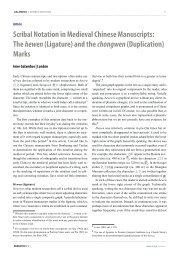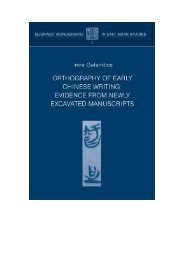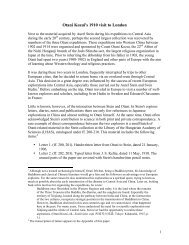Japanese 'Spies' along the Silk Road - Chinese manuscripts
Japanese 'Spies' along the Silk Road - Chinese manuscripts
Japanese 'Spies' along the Silk Road - Chinese manuscripts
You also want an ePaper? Increase the reach of your titles
YUMPU automatically turns print PDFs into web optimized ePapers that Google loves.
40 <strong>Japanese</strong> Religions 35 (1 & 2)<br />
marry, eat meat, wear non-monastic clo<strong>the</strong>s, even though in <strong>the</strong> West many of<br />
<strong>the</strong>se customs would be associated with laypeople’s practices. According to Ōtani’s<br />
own explication of <strong>the</strong>ir faith, it is in many ways analogous to Protestanism in <strong>the</strong><br />
West. 11 Jōdo Shin-shū (True Pure Land Sect) derives from Shinran 親鸞 (1173-<br />
1262), a Buddhist reformer of <strong>the</strong> 13th century. Ōtani himself was a direct line<br />
descendant of Shinran, and through marriage was related to <strong>the</strong> <strong>Japanese</strong> imperial<br />
family. He succeeded his fa<strong>the</strong>r as <strong>the</strong> 22nd Abbot of Nishi Hongan-ji which was<br />
<strong>the</strong> head organization for this branch of Shin Buddhism, encompassing thousands<br />
of temples and millions of followers. Tachibana also came from a family that owned<br />
a temple within <strong>the</strong> Nishi Hongan-ji branch.<br />
Nomura was one of <strong>the</strong> very few non-clergy followers of Ōtani. His fa<strong>the</strong>r<br />
used to work in his youth for Nishi Hongan-ji, and hence he grew up partially<br />
within this temple. His elder bro<strong>the</strong>r fell ill and died in Henan province when<br />
accompanying Ōtani on his first trip to China in <strong>the</strong> spring of 1899. Nomura<br />
himself was a veteran of <strong>the</strong> Russo-<strong>Japanese</strong> War of 1904-05, but in this he was<br />
not different from over a million of his fellow countrymen. Only in <strong>the</strong> last decisive<br />
battle at Mukden, <strong>the</strong> number of <strong>Japanese</strong> troops was estimated at 270,000 men,<br />
thus it is fair to conclude that a substantial portion of <strong>the</strong> young <strong>Japanese</strong> male<br />
population had participated in <strong>the</strong> war. Japan’s spectacular victory against Russia<br />
earned it a prominent place among <strong>the</strong> leading military nations in Asia. With<br />
Britain and Russia competing for control over Central Asia in what came to be<br />
known as <strong>the</strong> Great Game, Japan was an unexpected newcomer whose colonial<br />
appetite was soon appreciated by both powers. Although Britain entered into an<br />
alliance with Japan in 1902, it was never<strong>the</strong>less cautious with regard to potential<br />
<strong>Japanese</strong> intelligence ga<strong>the</strong>ring activities, especially after <strong>the</strong>ir 1905 victory over<br />
Russia.<br />
Naturally, <strong>the</strong> Russians were even more alert when it came to <strong>Japanese</strong> travelers<br />
in politically highly sensitive areas such as Xinjiang. Not surprisingly, <strong>the</strong> Russian<br />
Consul was aware of Nomura’s involvement in <strong>the</strong> war, even if his information<br />
about Tachibana was incorrect. As a similar example of misinformation about<br />
<strong>Japanese</strong> espionage and military activities in Xinjiang, <strong>the</strong> case of Mannerheim<br />
comes to mind, who visited Kashgar in 1906 on covert intelligence mission. After<br />
his arrival into town, Sergei A. Kolokolov, <strong>the</strong> Russian Consul showed him secret<br />
reports of <strong>Japanese</strong> activities sou<strong>the</strong>ast of <strong>the</strong> city. Mannerheim was skeptical about<br />
<strong>the</strong> rumors, as his diary reveals:<br />
11. Ōtani (1900). In this English language article, Ōtani writes that <strong>the</strong>y are <strong>the</strong><br />
Protestants of Buddhism and describes <strong>the</strong> analogies between Christian and Buddhist<br />
Protestanism.







